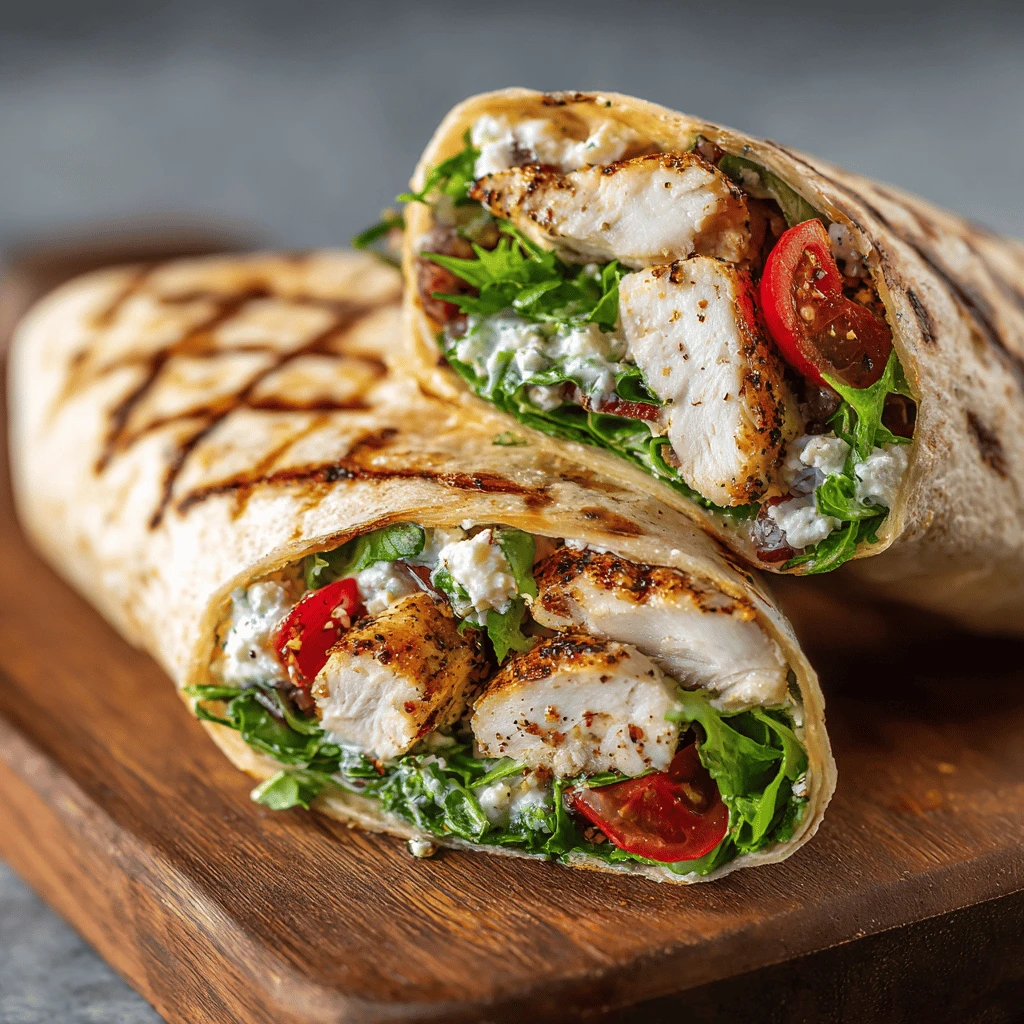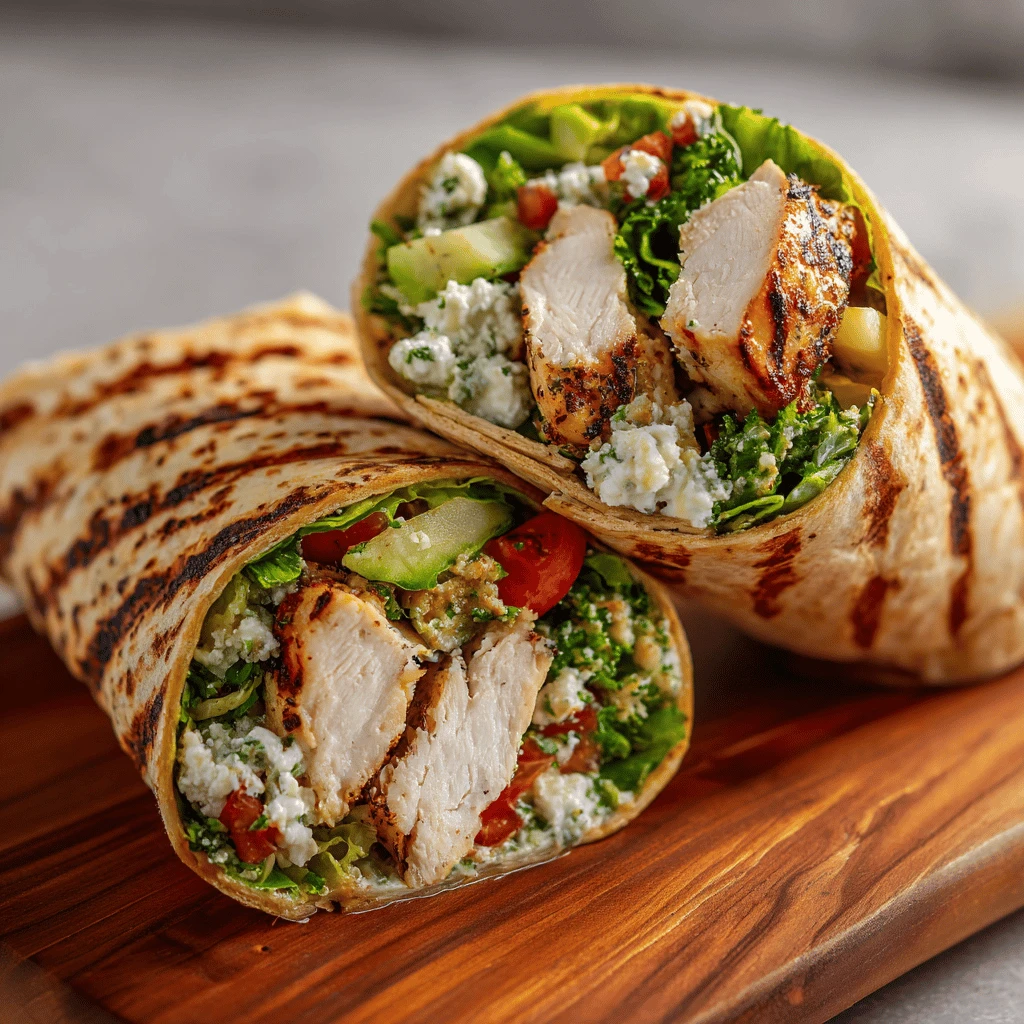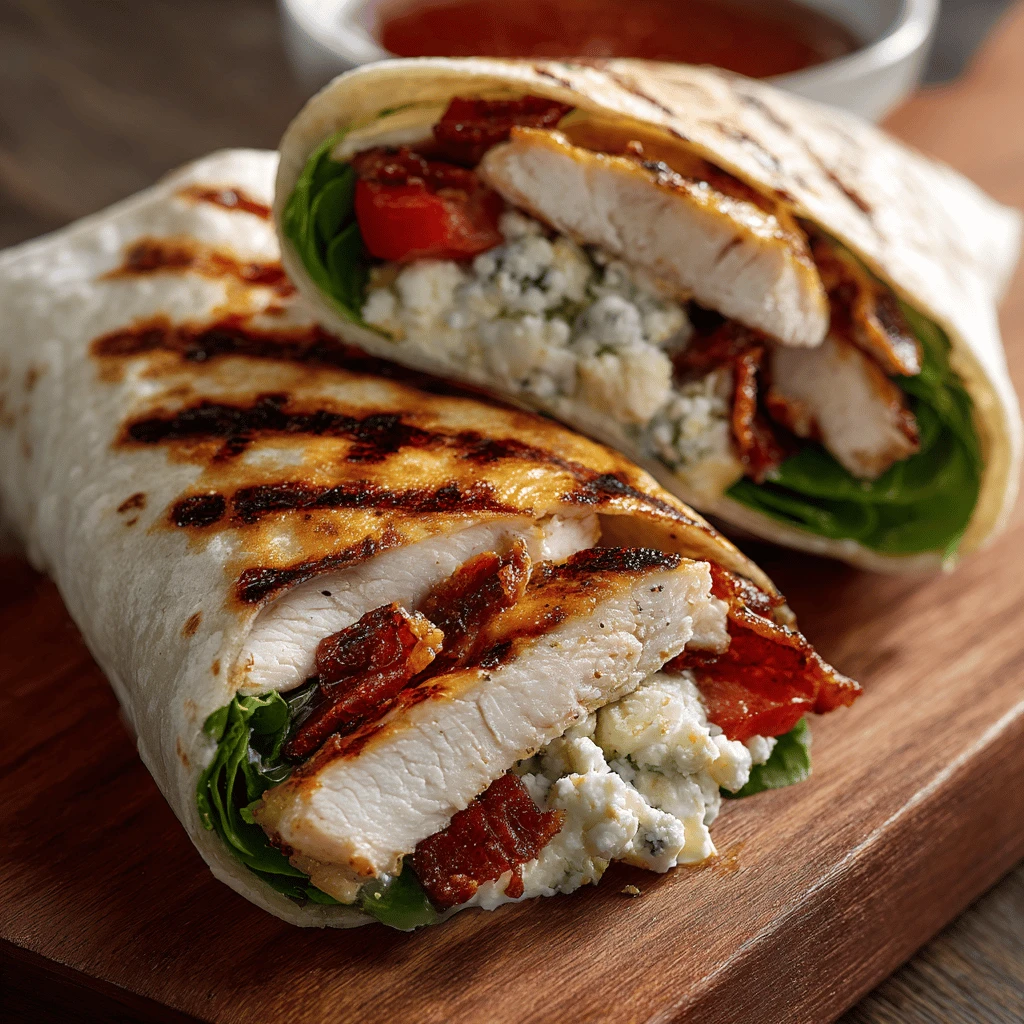Healthy Grilled Chicken Breast Wrap
The Ultimate Guide to Delicious and Nutritious Grilled Chicken Wraps
Grilled chicken breast wraps are a fantastic choice for a quick, healthy, and satisfying meal. They’re versatile, easy to customize, and packed with lean protein and essential nutrients. Whether you’re looking for a light lunch, a post-workout refuel, or a convenient dinner, these wraps offer a delicious and wholesome option. This guide will walk you through everything you need to know to create the perfect grilled chicken breast wrap, from choosing the right ingredients to mastering the grilling process and crafting flavorful combinations.
Section 1: Building Blocks of a Healthy Wrap: Ingredients Matter
The foundation of any great wrap is, of course, its ingredients. Let’s break down the core components:
Choosing the Right Chicken
- Chicken Breast: Opt for boneless, skinless chicken breasts. They are lean, cook quickly, and offer a good source of protein. Look for chicken breasts that are of uniform thickness to ensure even cooking. Consider buying organic or free-range chicken if your budget allows, as these options often prioritize animal welfare and may have a better flavor profile.
- Marinating for Flavor and Tenderness: A marinade is crucial for adding flavor and keeping the chicken moist during grilling. A simple marinade can consist of olive oil, lemon juice, garlic, herbs (such as rosemary, thyme, or oregano), salt, and pepper. You can also explore other marinade options like yogurt-based marinades (which tenderize the chicken), teriyaki marinades, or spicy chili-lime marinades. Marinate the chicken for at least 30 minutes, or ideally several hours, in the refrigerator.
- Preparation is Key: Before grilling, pat the chicken breasts dry with paper towels. This helps them to develop a nice sear. You can also lightly pound thicker chicken breasts to an even thickness, which ensures consistent cooking and prevents dry spots.
Selecting the Perfect Wrap
- Tortilla Options: The type of tortilla you choose significantly impacts the overall health and flavor of the wrap. Whole wheat tortillas are a good source of fiber and offer a slightly nutty flavor. Spinach tortillas add a boost of vitamins and minerals. Low-carb tortillas can be a great option for those watching their carbohydrate intake. Avoid overly processed tortillas that are high in unhealthy fats and artificial ingredients.
- Size Matters: Choose a tortilla size that is appropriate for the amount of filling you plan to use. Overfilling a small tortilla will make it difficult to wrap, while a large tortilla with too little filling will be bland and unsatisfying.
- Warming for Flexibility: Lightly warm the tortillas before assembling the wraps. This makes them more pliable and less likely to tear when you roll them. You can warm them in a dry skillet, microwave them briefly, or wrap them in a damp paper towel and microwave for a few seconds.
Load Up on Healthy Fillings
- Leafy Greens: Add a generous layer of leafy greens such as spinach, romaine lettuce, arugula, or mixed greens. These provide essential vitamins, minerals, and fiber.
- Vegetables: Incorporate a variety of colorful vegetables for added nutrients and flavor. Some great options include sliced tomatoes, cucumbers, bell peppers, red onions, shredded carrots, and avocado. Consider roasting some vegetables like sweet potato, squash, and beets to add depth to the wrap.
- Healthy Fats: Incorporate sources of wholesome fat for added richness and flavor. Avocado is an excellent choice, providing healthy monounsaturated fats, potassium, and fiber. A drizzle of olive oil or a small amount of nuts or seeds can also add beneficial fats.
- Beans and Legumes: Consider adding black beans, chickpeas, or other legumes for extra protein and fiber. These can help keep you feeling full and satisfied for longer.
- Cheese (Optional): If you choose to add cheese, opt for low-fat options like feta, goat cheese, or part-skim mozzarella. Use cheese sparingly to keep the wrap healthy.
Section 2: Mastering the Grill: Tips for Perfect Chicken
Grilling chicken breast perfectly is essential for a delicious and healthy wrap. Here are some tips to ensure your chicken is juicy and flavorful:
Preparing the Grill
- Clean Grill Grates: A clean grill is essential for preventing sticking and ensuring even cooking. Use a grill brush to thoroughly clean the grates before preheating the grill.
- Preheat the Grill: Preheat the grill to medium-high heat (around 350-450°F). This ensures that the chicken sears properly and cooks evenly.
- Oil the Grates: Lightly oil the grill grates with cooking oil or cooking spray to prevent the chicken from sticking. Use an oil with a high smoke point, such as canola oil or avocado oil.
Grilling Techniques
- Grilling Time: Grill the chicken breasts for approximately 5-7 minutes per side, or until they reach an internal temperature of 165°F (74°C). Use a meat thermometer to ensure accuracy. Avoid overcooking the chicken, as this can make it dry and tough.
- Avoiding Sticking: Do not move the chicken breasts immediately after placing them on the grill. Allow them to sear for a few minutes before flipping them. This will help prevent sticking and create nice grill marks.
- Even Cooking: If the chicken breasts are of uneven thickness, you can use a meat mallet to pound them to an even thickness before grilling. This ensures that they cook evenly and prevents some parts from drying out while others are still undercooked.
Resting the Chicken
- Importance of Resting: Allow the grilled chicken breasts to rest for at least 5-10 minutes before slicing or shredding. This allows the juices to redistribute throughout the chicken, resulting in a more moist and flavorful product.
- Covering While Resting: Cover the chicken breasts loosely with foil while they rest. This helps to retain heat without steaming the chicken.
Section 3: Delicious and Healthy Wrap Combinations
The possibilities for grilled chicken breast wrap combinations are endless. Here are a few ideas to get you started:
Mediterranean Chicken Wrap
- Ingredients: Grilled chicken breast, whole wheat tortilla, spinach, cucumber, tomato, red onion, feta cheese, Kalamata olives, and a drizzle of Greek yogurt dressing.
- Flavor Profile: Fresh, tangy, and herbaceous. This wrap is packed with Mediterranean flavors and healthy fats.
Spicy Southwestern Chicken Wrap
- Ingredients: Grilled chicken breast (marinated in chili powder and cumin), whole wheat tortilla, romaine lettuce, black beans, corn, bell peppers, avocado, salsa, and a dollop of Greek yogurt or light sour cream.
- Flavor Profile: Spicy, savory, and creamy. This wrap is a hearty and flavorful option with a Southwestern kick.
Asian-Inspired Chicken Wrap
- Ingredients: Grilled chicken breast (marinated in teriyaki sauce and ginger), spinach tortilla, shredded carrots, shredded cabbage, bean sprouts, chopped peanuts, and a drizzle of sesame dressing.
- Flavor Profile: Sweet, savory, and crunchy. This wrap is a lighter option with Asian-inspired flavors.
Lemon Herb Chicken Wrap
- Ingredients: Grilled chicken breast (marinated in lemon juice, herbs, and garlic), whole wheat tortilla, arugula, roasted red peppers, goat cheese, and a drizzle of olive oil.
- Flavor Profile: Bright, tangy, and slightly peppery. This wrap is a simple yet flavorful option that highlights the freshness of the ingredients.
Buffalo Chicken Wrap (Healthy Version)
- Ingredients: Grilled chicken breast (tossed in hot sauce), whole wheat tortilla, romaine lettuce, shredded carrots, celery sticks, light blue cheese dressing or Greek yogurt ranch.
- Flavor Profile: Spicy, tangy, and creamy. A healthier take on a classic buffalo chicken wrap.
Section 4: Assembling the Perfect Wrap: Techniques and Tips
Assembling a wrap might seem straightforward, but a few techniques can ensure a tidy and satisfying result.
Layering Ingredients
- Start with Greens: Begin by layering the leafy greens on the tortilla. This creates a barrier between the tortilla and any potentially wet ingredients, preventing the tortilla from becoming soggy.
- Add Chicken and Vegetables: Arrange the grilled chicken and vegetables on top of the greens. Avoid overfilling the wrap, as this can make it difficult to roll.
- Sauce Strategically: Drizzle the sauce or dressing over the ingredients, being careful not to add too much. Too much sauce can make the wrap messy and difficult to handle.
- Cheese Placement: If using cheese, sprinkle it over the ingredients before rolling the wrap.
Rolling Techniques
- Fold in the Sides: Fold in the sides of the tortilla towards the center. This helps to contain the fillings and create a secure wrap.
- Tightly Roll from the Bottom: Starting from the bottom edge of the tortilla, tightly roll the wrap upwards, keeping the fillings tucked inside.
- Secure the Wrap: If necessary, you can secure the wrap with a toothpick or by placing it seam-side down on a plate.
- Optional – Toasting: Lightly toasting the wrap in a pan or panini press helps to seal it and adds a delightful crunch.
Presentation Matters
- Cut in Half (Optional): Cutting the wrap in half diagonally makes it easier to eat and enhances its presentation.
- Garnish: Garnish the plate with extra vegetables, a drizzle of sauce, or a sprinkle of herbs to make the wrap more visually appealing.
Section 5: Tips for Making it Healthier & Staying on Track
Even healthy wraps can be optimized. Here are additional tips for keeping your grilled chicken breast wraps as nutritious as possible:
Portion Control
- Be Mindful of Fillings: Pay attention to the amount of each ingredient you add to the wrap. Overloading on high-calorie ingredients like cheese, fatty dressings, or excessive avocado can quickly turn a healthy meal into an unhealthy one.
- Smaller Tortillas: If you’re struggling with portion control, opt for smaller tortillas. This can help you to reduce the overall calorie and carbohydrate content of the wrap.
Dressing Choices
- Homemade is Best: Make your own dressings using wholesome ingredients like Greek yogurt, lemon juice, olive oil, and herbs. This allows you to control the amount of sugar, sodium, and unhealthy fats in your dressing.
- Light Options: If you’re buying store-bought dressings, choose light or reduced-fat options. Alternatively, opt for simple dressings like balsamic vinaigrette or a squeeze of lemon juice.
Sodium Awareness
- Watch the Sodium Content: Be mindful of the sodium content of your ingredients, especially processed meats, cheeses, and sauces. Choose low-sodium options whenever possible.
- Season with Herbs and Spices: Use herbs and spices to add flavor to your wraps instead of relying heavily on salt.
Meal Prepping for Convenience
- Prepare Chicken in Advance: Grill a batch of chicken breasts at the beginning of the week and store them in the refrigerator. This makes it easy to assemble wraps quickly during busy weekdays.
- Chop Vegetables Ahead of Time: Chop vegetables and store them in airtight containers in the refrigerator. This will save you time during meal preparation.
- Assemble Individual Wraps: You can even assemble individual wraps in advance and store them in the refrigerator for a quick and easy lunch or dinner. Just be sure to wrap them tightly in plastic wrap or foil to prevent them from drying out.
Staying Consistent
- Incorporate into Your Diet: Regularly including healthy grilled chicken breast wraps in your diet can contribute to a balanced and nutritious eating plan.
- Experiment with New Recipes: Don’t be afraid to experiment with different wrap combinations to find your favorites. This will help to keep your meals interesting and prevent boredom.
FAQ: Common Questions about Healthy Grilled Chicken Wraps
Q: Are grilled chicken wraps healthy?
A: Yes, grilled chicken wraps can be a very healthy meal option. They are packed with lean protein, vegetables, and healthy fats, and they can be customized to fit your individual dietary needs.
Q: How can I make a grilled chicken wrap low-carb?
A: To make a low-carb grilled chicken wrap, use low-carb tortillas or lettuce wraps. Fill with protein, cheese, and non-starchy vegetables. Limit high-carb ingredients like beans or high sugar sauces.
Q: What are some good sauces for grilled chicken wraps?
A: Great sauce options include Greek yogurt-based sauces, hummus, guacamole, pesto, light vinaigrettes, or a drizzle of olive oil and lemon juice.
Q: How long will grilled chicken wraps last in the fridge?
A: Assembled grilled chicken wraps will generally last for 1-2 days in the refrigerator. It’s best to store the wraps tightly wrapped to prevent them from drying out.
Q: Can I freeze grilled chicken wraps?
A: It’s not generally recommended to freeze fully assembled grilled chicken wraps, as the vegetables and tortillas may become soggy when thawed. However, you can freeze grilled chicken breast separately and use it to assemble wraps later.




